Museums the world over have no shortage of ideas for communicating with and winning over new audiences. The museum outside the museum, the museum as a familiar and welcoming place to live for all – this is what every curator is trying to do, to help people discover all the artistic heritage that they are responsible for protecting, celebrating, sharing and, of course, loving!
For example, recently in the columns of WUKALI, we were able to discover and enjoy the visits made to Barcelona’s Museum of Archaeology for dedicated audiences, in this case the Naturist Club of Catalonia. Decompartmentalize, that’s the word, a little levity in this world of brutes!
We are all witnessing an unprecedented acceleration in the pace of knowledge and its corollary, the speed of underlying communication, which makes a mockery of borders and social hierarchies, and at the same time, a worrying sociological and ethical destructuring. In short, an ontological definition of our society.
So, where do museums fit into all this?
Museums are coming out of their shells, in every sense of the word. What a pleasure, for example, to walk through the corridors of the Paris metro and see all those posters inviting travellers to visit an exhibition or attend a show. The French capital’s subway is teeming with invitations to life and beauty.
Culture, as we call it in our beautiful country, is the thirst to learn, to discover, to raise our sensibilities ever higher, to simply whet our curiosity. What seems normal to us, and may even appear indifferent to some, is in fact the exception. Anyone who has had the good fortune to travel the world knows that this is not always the case. In some of the world’s major capitals and cities – and some of them are much larger and more populous than Paris – their inhabitants don’t have the chance, or rather the privilege, of admiring art masterpieces in their own homes. This explains, among other things, why Paris leads the way in international tourism, as well as France’s reputation in the cultural sphere. The French poet Joachim du Bellay** once said France, mère des arts, des armes et des lois ( France was the mother of the arts, weapons and laws.)
The Rijksmuseum outside the walls
In the old days, every honest man had to make the trip to Rome, but the great European capitals were also a target for consolidating and deepening his intellectual and sensitive maturity. The same is true today, and Amsterdam is one of them. As a reverential admirer of Rembrandt, I couldn’t disagree more.
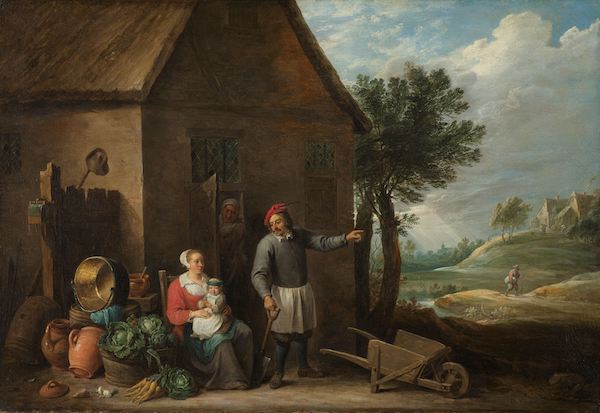
Prêté par la ville d’Amsterdam (legs A. van der Hoop).
We’re fond of the Netherlands, a country of tolerance whose history has been marked by cruel upheavals, a country that also embodies a certain idea of Europe, this Northern Flanders, which is also well known to us thanks to the painters who captured a certain climate, of its low skies, its raw, cold winter light, but also and above all of this sense of rapport with others, this quality of linear urban or village life on a daily basis and man’s mastery of nature. From Ruysdael to Seghers or Hobbema, nature is kept calm and quiet, as if sheltered from the movements of the world.
This Europe, and I come back to this, far from the inane wokist stereotypes circulating in our media, is also obviously a certain art of living, and of existing. It’s a relationship with the simplest, most basic, most natural part of everyday life, quite simply food, and this is the subject of the exhibition presented by the Rijksmuseum. A soothing, familiar and serene moment in life.
Outside the walls, then, and at Schiphol airport in Amsterdam, the Rijskmuseum is making itself at home, allowing travellers to get away from it all for a while, probably to get some fresh air, but also to put down some roots in a hectic world. The exhibition is called XVII century Dining culture.
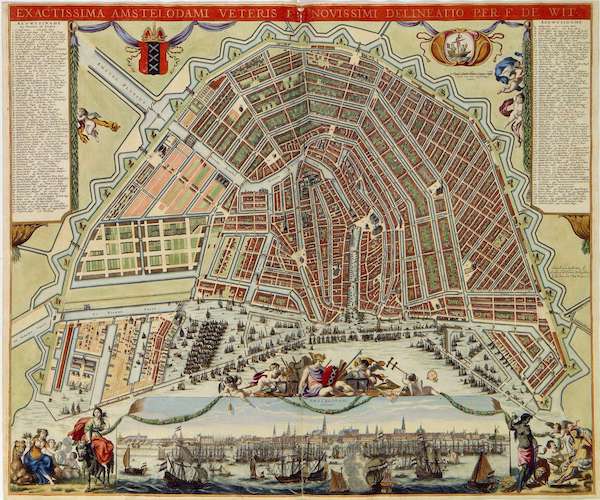
©Bibliothèque royale, La Haye
This is how eight paintings belonging to the Rijksmuseum can currently be seen in one of the airport’s lounges*, their common theme the art of the table and eating in the 16th century by painters: Gabriël Metsu, Abraham Mignon and Cornelis Dusart.
The beautiful vegetables, the plump cabbages with their fleshy green leaves, the fruit, the grapes bursting with juice and the lemons, perfect examples of the economic dynamism of the Netherlands and the far-flung exchanges generated by dynamic trade, are already a source of envy. Here, then, is an abundance of rich nature for the pleasure of viewing and tasting. Unlike the paintings of the South Flanders masters, these are much more than still lifes – they are the structuring, or more precisely, the expression of the vital impetus of the Dutch society of the time, and of the symbiosis of beings and things brought together in a humanistic and generous unity.
What are the subjects, what are the themes, let’s find out!
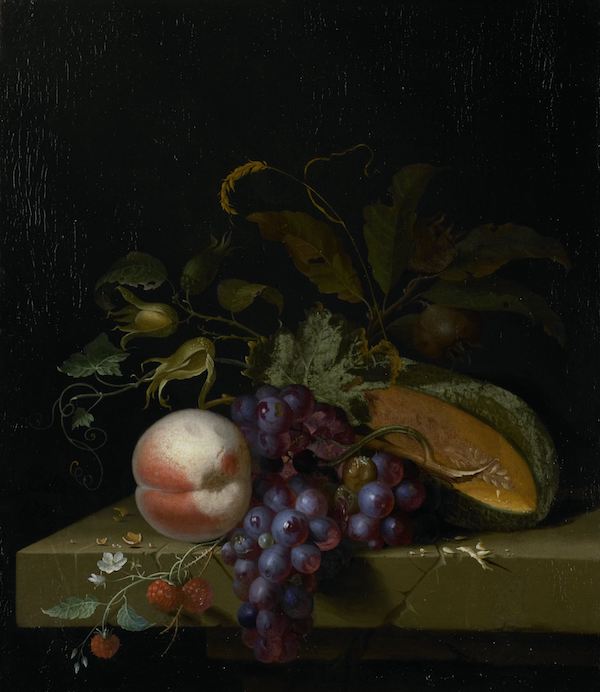
Abundance
The rapid growth of trade in the 17th century brought about major changes in Dutch gastronomic culture: wealthy citizens began to use Chinese porcelain objects as centerpieces on richly decorated tables, and to supplement local products with foodstuffs from all over the world. Still lifes are clear evidence of this evolution. The 1651 Still life with Roemer wine glass, flute glass, clay jug and pipes by Jan Jansz van de Velde III, for example, also features tobacco and salt brought to the Netherlands by the Dutch West India Company (WIC). Pieter Gallis‘ Still Life with Fruit (1673) features a series of fruits from China and Persia.
Rembrandt, for example, took advantage of his richly endowed marriage to Saskia van Uylenburgh to buy a number of luxury items (porcelain, tableware, furs, carpets), which are also represented in his paintings.
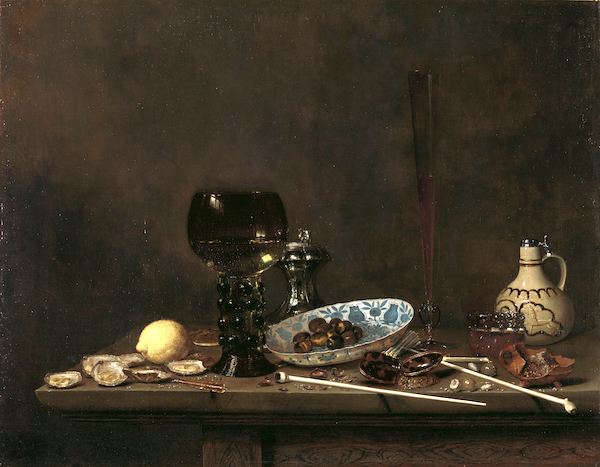
Let’s make no mistake: these exquisite paintings, these refined depictions of an industrious, active society, intrinsically possess the symbolic codes of the older masters. Beyond the Adamic vision of the products of the earth and the foodstuffs, fruits and vegetables, offered to the gaze and contemplation, also pierce the message of the fragility of things and the limitation of time. This still life by Jan Jansz van de Velde (III), on show at Schiphol airport, has all the codes, and the clay pipes in the right foreground (church warden, a reference to the Dutch flavored tobacco smoker I once was) are much more than an anonymous decorative element, they represent the fragility of life.
Bread, cheese and ham
In those days, ordinary families had to make do with a menu of little variety, so breakfast consisted mainly of bread, cheese and ham, as can be seen in Gabriël Metsu’s Man and Woman at Rest (1650-1660). In the same painting, the woman can be seen filling a flute glass with beer. And yes, in those days, still water was rarely drunk, but beer was consumed throughout the day.
Artichokes
It’s striking to note the presence of artichokes alongside carrots and cabbages in David Teniers II’s The Husbandman at the Door of a House with a Seated Woman and Child (c. 1650-1655). Artichokes were a novelty in the Netherlands at the time. Originally grown in the Mediterranean region, they had only been introduced to northern Europe in the 16th century.
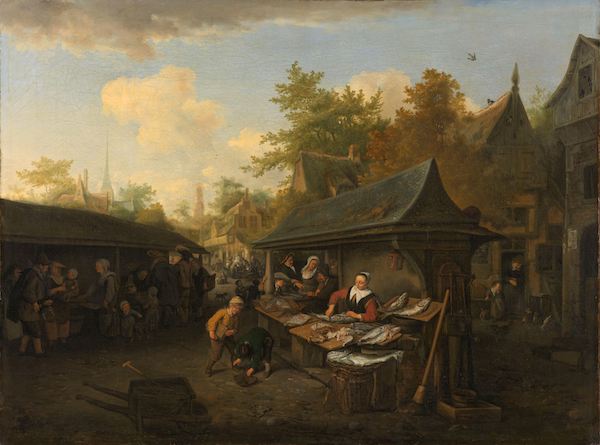
Fish stalls
Cornelis Dusart’s Fish Market, painted in 1683, shows a stall of freshly caught fish behind which a woman is busy selling. In those days, it was quite common for middle-class women to sell food and other items to earn a living. Women were even in the majority in the fish trade, where they exercised a variety of professions. What fine technical and pictorial material to capture the freshness of the seafood.
Exposition du Rijskmuseum à l’aéroport de Schiphol
XVII century Dining culture, de novembre 2023 à novembre 2024
*L’exposition se situe entre Lounge 2 et 3, après avoir passé la sécurité de l’aéroport
** Joachim du Bellay, poète français (1522-1560)
Illustration de l’entête: Homme et femme. Gabriel Metsu. 1650-1660
You can get back to the original French text just in clicking.


